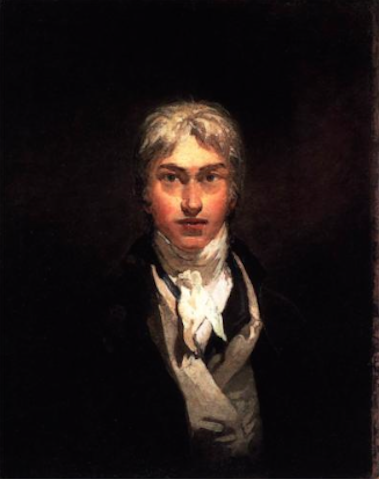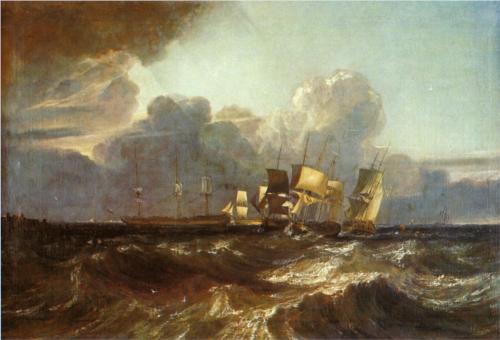J.M.W. Turner (1775-1881)

Self-Portrait
by William Turner, used under Public Domain
Joseph Mallord William Turner was “the most versatile, successful, and controversial landscape painter of nineteenth-century England” (Metropolitan Museum of Art). In an era where art that depicted landscapes and real-world environments was largely plain and straightforward, Turner’s style strayed away from the norm. His landscapes were often full of chaos and motion, which was shocking and even appalling to people at the time (Doran).
There were also messages of revolution and societal advancement within many of his paintings. As strange as it seems to us today, Turner’s work – and the way it was seen during his time – make him one of the most controversial figures in European art.

Ships Bearing up for Anchorage
by William Turner, used under ![]()
Turner is credited with creating new watercolor techniques to portray landscapes. The way he blended colors in his skies and clouds make led to him being known as the “painter of light” (BBC). The “color harmonies” that resulted from these techniques allowed for much more creative expression, rather than purely representational depictions.
The Fighting Temeraire, first exhibited in 1839, is a piece that reflects a changing of the times in Britain. It depicts a traditional sailboat being towed along in the water by a much faster and more powerful steam boat, signifying the advances in technology that meant tradition would become secondary to innovation (Bates).

The Fighting Temeraire tugged to her last berth to be broken up
by William Turner, used under ![]()
Soon after his rise to prominence, Turner became the most notorious and well-known artist of his day. Despite this, he kept to himself and worked in total isolation from the outside world. Late in his life, he broke away from all family and friends and essentially disappeared. Many believed that he saw his work as the only thing that mattered, and that it could speak for itself so he shouldn’t need to.
The Tate Art Gallery in London gives a prestigious award each year called the Turner Award. In the spirit of J.M.W. Turner’s work and legacy, the recipients of this award are often controversial and revolutionary in their own art.
An online gallery with many more of Turner’s paintings can be viewed here.
______
Bates, C. (2013, April 25). Turner’s Fighting Temeraire – Britain’s journey from sail to steam. BBC News. Retrieved April 13, 2014, from http://www.bbc.co.uk/history/0/22301464
Doran, A. (2008, July 29). J.M.W. Turner. J.M.W. Turner | TimeOut Art . Retrieved April 13, 2014, from http://www.timeout.com/newyork/art/j-m-w-turner
Metropolitan Museum of Art. (n.d.). Joseph Mallord William Turner. Heilbrunn Timeline of Art History. Retrieved April 13, 2014, from http://www.metmuseum.org/toah/hd/trnr/hd_trnr.htm
Turner, W. (1799). Self-Portrait. [Painting]. Retrieved from http://www.wikipaintings.org/en/william-turner/self-portrait-1. Public domain image.
Turner, W. (1802). Ships Bearing up for Anchorage. [Painting]. Retrieved from http://www.wikipaintings.org/en/william-turner/ships-bearing-up-for-anchorage-the-egremont-sea-piece-1802. Public domain image.
Turner, W. (1839). The Fighting Temeraire tugged to her last berth to be broken up. [Painting]. Retrieved from http://www.wikipaintings.org/en/william-turner/the-fighting-temeraire-tugged-to-her-last-berth-to-be-broken-up-1839. Public domain image.
